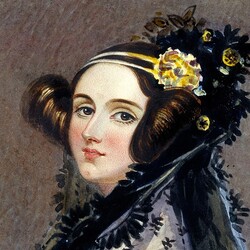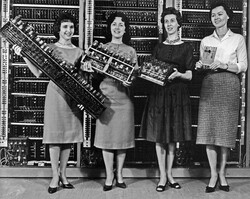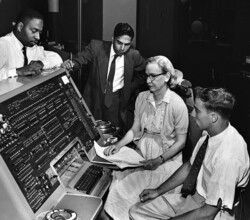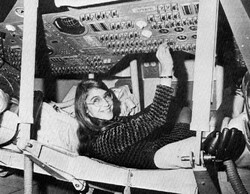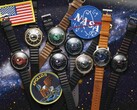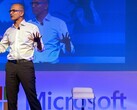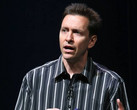Today, the word "computer" refers to the machines we know and love, but as far back as the early 1600s, it was used in terms of actual human beings whose jobs involved high-level math. They typically assisted project leaders and performed tedious calculations, and over three centuries later, these human computers were responsible for the development of ENIAC, widely considered the world's first electronic computer.
History, however, has not offered a ton of recognition to the women who helped fill this field of work. Even as World War II caused labor shortages and women flocked to take advantage of the resulting employment opportunities, they were relegated to footnotes, and in many cases, their contributions were minimized, glossed over, or outright ignored when compared with those of their male counterparts. For this reason, many influential early computer engineers were lost to history, but that's not to say there's no record of important women throughout the history of the tech sector.
There are complex, societal reasons behind this relative dearth of representation in the history books, but part of the issue was inarguably due to the placement of men in corporate and team leadership positions. In fact, the tedious work of early programming was often considered "women's work," or the type of busywork that some men considered minimally important to their advancement.
Nevertheless, and thankfully, there are plenty of inspiring female figures that all modern computer users should appreciate. There's no shortage of biographies and history lessons about the male contributors to the field, and here we'll bring to light just a few of the most important and interesting women to work in computing.
Ada Lovelace, the first computer programmer
More than 100 years before the transistor became the star of the show, Charles Babbage dreamed up the Analytical Engine, a mechanical computer designed to accept data inputs in the form of punch cards. While it was never actually assembled during Babbage's lifetime, the ingenuity of the day's engineers could not be stopped: Through theoretical calculation and application of both logic and creativity, Ada Lovelace became the first researcher to recognize the machine's potential in regard to complex problem-solving.
In the early 1840s, Lovelace translated a French engineer's work on the proposed machine and offered her own lengthy annotation along with it. While most minds of the time imagined the device solely capable of simple calculation, Lovelace included a complex algorithm that many consider to be the first computer program. Some historians also attribute a certain level of mathematical genius to Lovelace, to the point where they claim that she contributed heavily to the development of the Analytical Engine itself.
There is some disagreement as to whether she did actually write that important algorithm, and some researchers hold that she was not involved in any meaningful way in the advancement of Babbage's mechanical computer. What most do agree on, though, is that she was a conceptual prophet of modern computing.
When most engineers were focused on the direct computational function of the machine, she was more interested, and indeed more outspoken, about the future potential for computers. She even referenced artificial intelligence, stating, "The Analytical Engine has no pretensions whatever to originate anything. It can do whatever we know how to order it to perform." This was at the same time a relatively stark dismissal of artificial intelligence and probably the first seed of the popular "garbage in, garbage out" idiom.
Sadly, Lovelace passed away at the young age of 36 due to cancer and likely complications from the, shall we say, substandard medical care of the 19th century. Nonetheless, her name and legacy live on as one of the first women to make a huge difference in the computing world.
The Women's Army Corps, ballistic research, and ENIAC girls
In one of the most blatant and prominent oversights (or, arguably, intentional dismissals) of the 20th century, even avid technology fans are often unaware of the impact that a relatively small group of extremely talented young ladies had on the development of ENIAC.
As the aforementioned war effort ravaged the ranks of many male engineers, the Women's Army Corps was formed out of a handful of recent graduates and trained mathematicians who answered local job advertisements and were placed into advanced training courses with distinctly war-related subject matter.
Their first main focus was ballistics calculation, much of which would ultimately take place at the Ballistics Research Laboratory in Aberdeen, Maryland. Training also occurred at the University of Pennsylvania and alternated between raw number-crunching and working with a mechanical computer called a differential analyzer at the BRL. In the absence of real programming languages, six students emerged from the extended training with the expertise the project needed and received the assignment to assemble ENIAC, a digital computing device the likes of which the world had never seen.
Kay Antonelli, Jean Bartik, Betty Holberton, Maryln Meltzer, Frances Spence, and Ruth Teitelbaum experienced resounding success by December of 1945, when ENIAC finally went online. A major part of the difficulty of their task was that they didn't actually have much of a roadmap, due to the unprecedented nature of the project. It's also worth noting that one of their senior professors, Adele Goldstine, largely oversaw the creation of the first stored instruction methods for ENIAC, which provided it with a more general-purpose function than its basic design allowed.
So why aren't these women more widely celebrated today, when they played an inarguably important role in the early tech sector? Well, to be clear, they do tend to get more recognition now than in the past (and especially so, as compared to their recognition at the time). Until the last few decades, though, even the large number of pictures of the women working to assemble ENIAC didn't help give them credit, as they were often seen as simple "refrigerator girls," a dismissive term describing models present in appliance advertisements for purely aesthetic purposes.
The main contributor to their relative obscurity, though, is probably more systemic and societal than their dismissal as simply pretty faces. Leading up to and continuing through the Women's Army Corps training at the University of Pennsylvania and the BRL, men increasingly saw the repetitive, tedious activity of calculation and human computing as unhelpful to their ultimate career goals. This contributed to and was exacerbated by a gender-based segmenting of roles within the school and corps as a whole.
Today, of course, the tech sector is largely occupied by men, to the point of sometimes controversial workplace standards and unbalanced representation in salaries, recognition, and media. It's impossible to ignore, however, that the first computer builders and programmers were, in many cases, not men at all.
Grace Hopper, Queen of Software
During the early stages of programming, instructions were even more esoteric than today. Esteemed US Navy rear admiral (lower half) Hopper changed all that by developing a language called FLOW-MATIC, which operated using relatively simple English commands, as opposed to the hard-to-understand symbols and structures of the methods used up to that point.
It took years of work to get senior engineers to accept even the concept of talking to computers in English. Ultimately, one of Hopper's most notable contributions was the creation of the first-ever compiler, a relatively complex program that translates real words into language a computer can understand. It was this seminal feat that garnered her the nickname "Queen of Software," after she and her committee created the landmark language COBOL.
Hopper's career was initially jumpstarted by her initial inclusion in the Mark 1 computer and UNIVAC I just a few years later. Both of these were spiritual successors to ENIAC, and the second was a product of the company led by John Mauchly, husband of Kay McNulty of the original ENIAC girls. This wasn't her only innovation, though, as in the following decades she would help with decentralized reorganization of Navy networks in addition to contributing to a range of systems tests that eventually found their way to the National Institute of Standards and Technology.
Later in life, it became more apparent than ever that Hopper was as charming and down-to-earth as she was creative and hardworking. A reasonably well-known 1986 interview with David Letterman illustrates her fun spirit, sharp wit, and the ease with which she communicates and explains novel concepts. These factors all had plenty to do with her later career as an industry speaker and goodwill ambassador, and she ultimately received endearing nicknames such as "Grandma COBOL" and was described as having the appearance of "all Navy," but the spirit of a pirate.
Margaret Hamilton and the moon mission
Margaret Hamilton's first focus was on abstract mathematics, but upon enrollment in meteorology at MIT she took a step towards the concrete and began designing weather prediction software. This was a decade before humans set foot on the moon, and after roughly two years of meteorology programming, she transitioned to working in MIT research labs, developing software for the US Air Force. It was that experience that led her to become the Director of Apollo Flight Programming at MIT's Draper Laboratory.
Not only is Hamilton responsible for designing ultra-reliable software and leading the team of programmers to implement it, she's credited with coining the term "software engineering" and has contributed greatly to conceptual and structural aspects of coding for decades. She, as well as the similarly influential and empowering Grace Hopper, has been awarded numerous standout awards, including the Presidential Medal of Freedom, the highest honor the US President can bestow upon a person for duties performed in civilian life.
Between Hopper and Hamilton, we see two women who possibly contributed more to the field of programming and software as a whole than any two men ever have before or since.
Games and game development
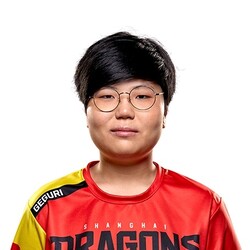
Despite some people's misguided notions, women have made up nearly half of video-gamers in the last few years. As one might expect, their numbers are considerably lower behind the scenes, but there are certainly influential developers and advocates throughout the industry. Among the most well-known is Roberta Williams, co-founder of Sierra Online, whose King's Quest series led the transition from antiquated text-based software into graphical games (especially graphic in the case of the studio's horror titles such as Phantasmagoria). Today, there are large numbers of women in leading or otherwise major roles through the sector.
Innovators such as Nicole Lazzaro, Megan Fox, and Holly Liu have leveraged their significant design experience into successful indie studios. Jade Raymond, who started the Ubisoft Montreal office famous for the Assassin's Creed franchise, now works for tech giant Google as the Vice President of Stadia Games. Bonnie Ross leads the famous 343 Industries responsible for Microsoft's Halo franchise, Amy Hennig is a co-creator of the Uncharted series, and Kellee Santiago is the Head of developer relations at Pokemon Go's parent company, Niantic.
Driven and socially conscious women also frequently make an effort to make a difference outside of directly making games. Tanya DePass runs a nonprofit organization dedicated to raising minority representation in games and the game development world, Tina Amini is the Editor-in-Chief of IGN's game department, Amber Dalton is a Senior Director at Twitch, Kate Edwards is a geographer and founder of consultancy Geogrify to advise designers on including culturally and geopolitically accurate content, and Nika Nour works with the IGDA Foundation to advocate for diversity and inclusion as well as for the Liminal Esports group as chief strategy officer.
The future of women in the computing world
It's hard to say what will happen in terms of women in the tech sector in the coming years. Female enrollment in computer science majors has dropped in recent years and there are all-too-frequent questions about corporate culture and glass ceilings that can be even more pronounced than in other industries. Nonetheless, there are quite a few professionals and organizations focused on closing the gender gap, and even huge companies such as Netflix, Intel, and Slack have enacted inclusion-oriented methods and employee-friendly benefits in an effort to retain a more diverse workforce.
While Samus Aran (Metroid) was one of the original inspiring female characters in gaming, newer titles offer ever-more-complex protagonists and storylines that can many players can learn from or empathize with. It may be wishful thinking, but it seems like even just a few years after the Gamergate incident, the gaming community and general public are realizing that such ugly incidents aren't indicative of a majority of gamers, but rather are unfortunately amplified, and luckily rare, outbursts of anger from extremely vocal yet slim minorities.
Of course, all of these women, their endeavors, their struggles, and their accolades are only a small portion of the reality. As always, we welcome your input in the comments. We would love to hear of your favorite influential figures from history, or from the modern industry, as well as your favorite female video-game characters. We're also interested in any insights our readers have on diversity, inclusion, and the future of women in the computing workplace. Thanks for reading!



